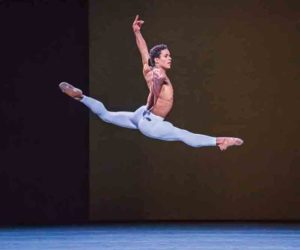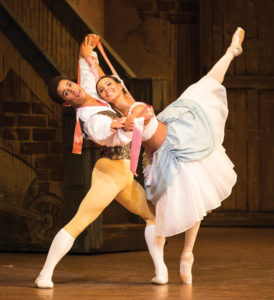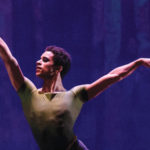In Conversation: Royal Ballet first soloist Marcelino Sambé chats with Gerard Davis - Vancouver Ballet Society
- Home
- Features 2015 - 2019
- In Conversation: Royal Ballet first soloist Marcelino Sambé chats with Gerard Davis

by Gerard Davis
It’s late summer in London and pouring rain as I make my phone call to Lisbon. At the other end of the line, newly promoted Royal Ballet first soloist Marcelino Sambé tells me he is sitting on his balcony in glorious sunshine, waiting for the start of the new season. It’s a rare moment of rest for the 24-year-old Portuguese dancer after a hugely successful year that saw him established as an artist to be reckoned with.

Aside from critically acclaimed performances in works as diverse as Crystal Pite’s Flight Pattern, Balanchine’s Tarantella, Liam Scarlett’s Symphonic Dances and Frederick Ashton’s The Dream, he managed to impress notoriously demanding Financial Times critic Clement Crisp, who described his Colas as the best he’d seen since the original La Fille mal gardée casting of David Blair in 1960, topping even Baryshnikov.
Sambé’s blossoming dance partnership with young principal Francesca Hayward is getting people just as excited.
“When I saw Frankie for the first time,” he says, “I knew she had this special quality of being natural and showing the inside of her heart. Every time I dance with her, I feel I might be getting closer to achieving that myself.” This humble desire for learning reveals much about how Sambé operates both as a dancer and a person.
His background is atypical for a ballet dancer. He grew up in Alto da Loba, a small town on the outer reaches of Lisbon, training in athletics, particularly hurdling, and also in African dance at a local community centre with a group called Estrelitas Africanas (Little African Stars). “I was five or six and tiny, but I was naturally flexible and loved showing off,” he recalls. “I was the only guy in the group, so I kind of became their mascot.”
He describes growing up within an “unstable biological family,” and seeing a psychologist at the community centre from a young age. This psychologist saw his African dancing and felt he might have enough talent to become a professional dancer. Sambé says he didn’t think too much of this, but, at eight years old, he decided to audition for Lisbon’s National Conservatory Dance School. “I’d never been to the centre of Lisbon before and figured it would be a nice day out,” he laughs.
It wasn’t your run-of-the-mill audition. “I didn’t know anything about ballet and didn’t have proper kit, so I had to dance in my socks. They asked me to improvise to some Scott Joplin music and I started doing my African choreography. I remember seeing the jury laughing because it was quite a weird combination, but I got in.”

He enjoyed school. “The directors and teachers believed in me and pushed me hard — it was pretty intense. I learned a lot about discipline and they treated contemporary dance and ballet as equals, which meant I could be both types of dancer. Also, I was quite lucky to have a friend who was already there and who was one of the best students in the school. I looked up to him and he kept me on the right track.”
At the end of his first year, tragedy struck when his father died; his mother found herself unable to cope, and he spent the next three years as a foster child. “My adopted mum and dad were super-supportive. They’re so intelligent and down-to-earth, and they’re still my rocks.”
He also gained another sister because his foster parents had a daughter, Maria Barroso, who was studying at the same school. “She’s inspiring,” he says. “Maria was so focused on becoming a ballerina and on being the best she could. We would come home at night, do stretches together and watch ballet videos — we became obsessed with ballet. She’s now dancing with the National Ballet of Portugal.”

As he got older, Sambé started taking part in international competitions, winning a silver medal at the Moscow International Ballet Competition in 2008, first prize at the Youth America Grand Prix in 2009, and a gold medal and special award at the USA International Ballet Competition in 2010. It was the Prix de Lausanne when he was 16 that had the most profound effect; the late Gailene Stock, director of the Royal Ballet School, saw him perform and offered him a scholarship in London. “My goal was to finish my studies at a prestigious school and that’s exactly what happened.”
He didn’t make it easy for himself, however. “I didn’t have much fun in a social sense because from day one I had a plan to get better. I had to be honest with myself; I looked at my new colleagues who were tall, handsome and had amazing physiques, and knew that wasn’t going to be my journey. I would have to find something else to distinguish me from all these beautiful dancers, so I worked my butt off.”
His hard work paid off. At the end of the second of his three scheduled years, he was offered a contract with the Royal Ballet. “I’m living probably the most exciting time of my life at the moment,” he says. “You know, when you’ve been onstage for 10 years, people start looking at you as though you’re old news already, but at the moment everything is new, and I’m riding the wave.”
That includes working with some of the most important names in contemporary choreography — Pite and Hofesh Shechter have both chosen him to perform in their Royal Ballet commissions. “Every time it’s announced that a contemporary choreographer is coming, I get excited and hope I get to work with them. Someone from outside the Opera House brings a different approach and that broadens your horizons and makes you a more versatile dancer.”
Sambé can be regularly seen in the wings of the Covent Garden stage diligently watching performances, even when he’s not in the show. When I ask who’s influenced him the most, he admits he can’t pin it down to one person. “It’s such a major question, it’s kind of overwhelming.”
He’s also established himself as a young choreographer to watch. In 2011, his M’ cã cré sabi (I Don’t Want to Know) won second prize in the prestigious Ursula Moreton Choreographic Awards, and, in 2012, he was chosen as one of Youth Dance England’s Emerging Choreographers. Last year, he created Land of Nod for New English Ballet Theatre. He’s pragmatic about this side of his ability. “I get inspired every time I listen to music or see a piece of art or a play, but I’m so busy at the moment that the choreographic part of me is put to the background. Working with New English Ballet Theatre was a nice taste of what I want in the future, but right now I need to concentrate 100 percent on my dancing.”

He remains, however, a devoted painter. “I can’t be without it,” he says. “It’s a form of personal expression and, although it’s a private thing, I like to see my colleagues’ reactions. Some of them say my paintings are horrendous, but others enjoy looking at them. They are colourful and abstract, but they do show people what’s going on inside my mind.”
In conversation, Sambé comes across as joyful and positive, an outlook he seems to carry around with him wherever he goes. “I get a lot of energy when everyone around me is in a good state. I feel at my best when my friends and family are happy; it puts me in the same spirit.”
We talk briefly about the upcoming season, where he has some big roles to prepare, such as Hans-Peter in The Nutcracker and a first revival of Shechter’s Untouchable. He tells me how much he’s looking forward to some major debuts in the second half of the season, including Lescaut in Kenneth MacMillan’s Manon (alongside David Hallberg and Natalia Osipova), and Albrecht, his first lead role in one of the great 19th-century classics, with Hayward as his Giselle. Then, with a cheery goodbye, we finish our conversation and, for him, it was back to the Portuguese sunshine.

